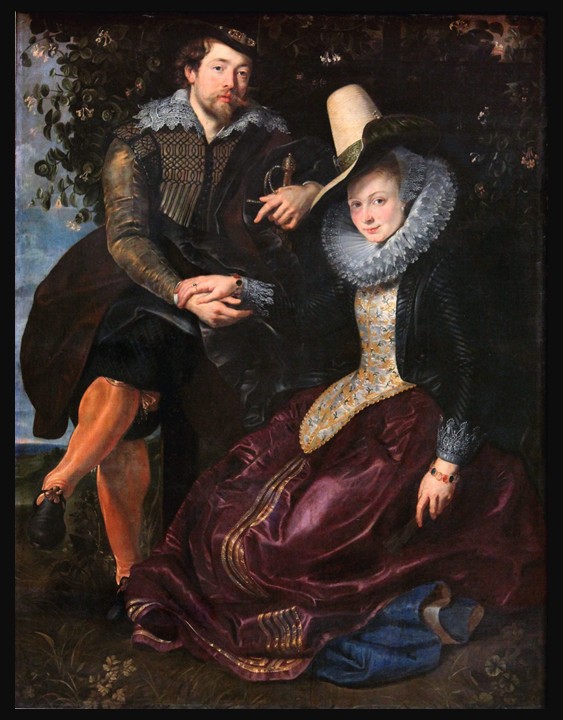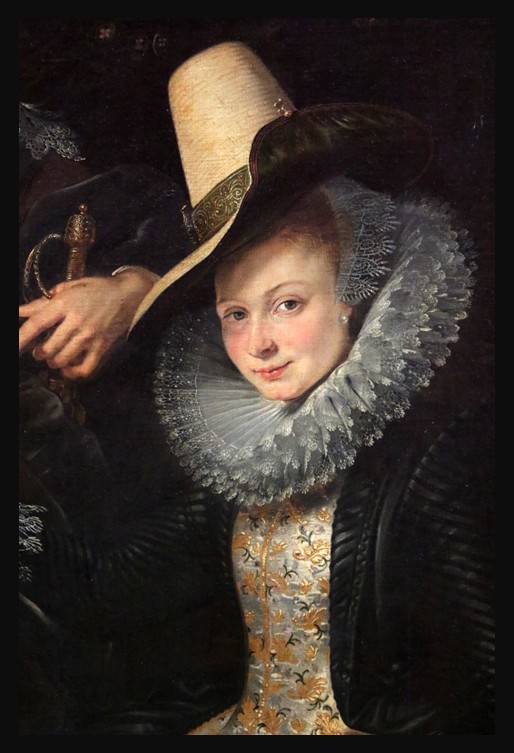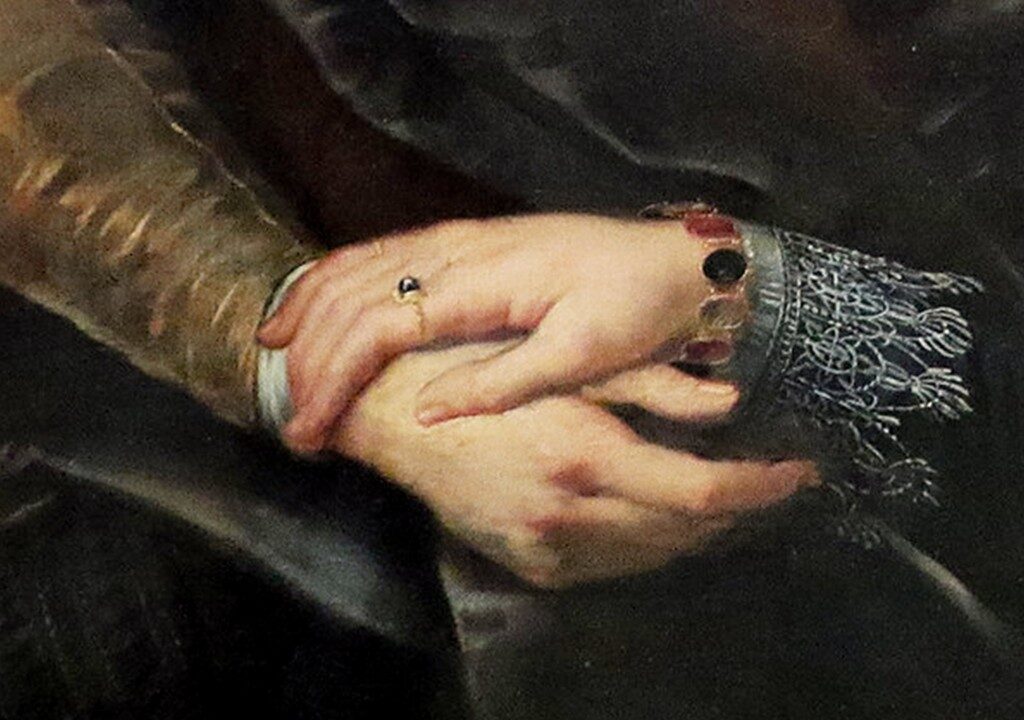
Rubens and Isabella Brant in the Honeysuckle Bower, c. 1609–10, Oil on Canvas, 178 x 136.5 cm, Alte Pinakothek, Munich, Germany https://smarthistory.org/peter-paul-rubens-and-isabella-brant-in-the-honeysuckle-bower/
You can almost smell the sweet fragrance of honeysuckle wafting from the intimate garden alcove in Peter Paul Rubens’s masterpiece, Peter Paul Rubens and Isabella Brant under a Honeysuckle Tree. This luminous double portrait captures the artist and his new bride, Isabella Brant, in a moment of idyllic serenity and mutual devotion. Painted around 1609-1610, shortly after their marriage, the composition brims with symbolism, celebrating the promise of wedded bliss and steadfast marital fidelity. Likely created as a personal tribute and a gift for Isabella’s father, this work reflects Rubens’s mastery in blending naturalism with allegorical depth, offering a glimpse into the couple’s bond through an exquisitely tender lens. https://smarthistory.org/peter-paul-rubens-and-isabella-brant-in-the-honeysuckle-bower/
Peter Paul Rubens stands as one of the towering figures of the Baroque era, renowned for his dynamic compositions, masterful use of colour, and ability to convey emotion and movement. Born in 1577 in Siegen, in present-day Germany, Rubens rose to prominence as a court painter and diplomat, blending his artistic genius with his refined cultural sensibilities. His works, characterized by dramatic contrasts of light and shadow, vibrant palettes, and intricate detailing, encapsulate the grandeur and exuberance of the Baroque style. Beyond religious and mythological themes, Rubens excelled in portraiture, landscapes, and historical allegories, often infusing his pieces with rich symbolism and humanistic depth. His prolific output and influence extended beyond his lifetime, shaping the trajectory of European art and securing his legacy as one of history’s most celebrated painters.

Rubens and Isabella Brant in the Honeysuckle Bower (detail), c. 1609–10, Oil on Canvas, 178 x 136.5 cm, Alte Pinakothek, Munich, Germany https://smarthistory.org/peter-paul-rubens-and-isabella-brant-in-the-honeysuckle-bower/
Isabella Brant, the first wife of Peter Paul Rubens, was not only the artist’s muse but also a central figure in his life, embodying the harmony and affection that defined their relationship. Born into an affluent family in Antwerp, Isabella married Rubens in 1609, shortly after his return from Italy. Their union coincided with the early blossoming of Rubens’s career, and Isabella played a key role in his personal and professional stability, supporting him during a period of prolific artistic achievement. She was frequently featured in Rubens’s work, immortalized in portraits that reveal her grace, warmth, and intellect. Their life together was marked by mutual respect and joy, enriched by their shared love of art and culture. Tragically, Isabella’s life was cut short in 1626, but her memory endured through Rubens’s poignant depictions and the enduring influence she had on his art and life.
Peter Paul Rubens’s Peter Paul Rubens and Isabella Brant under a Honeysuckle Tree feels like stepping into a deeply personal moment, where art transcends the canvas to tell a story of love and connection. What makes this painting so remarkable is how it invites you to share in the intimacy of Rubens’s life, making you feel like a privileged witness to a quiet moment of wedded bliss. The tender gestures, like their intertwined hands, speak volumes about the bond they shared, while the vibrant honeysuckle tree envelops them in a world of natural beauty and symbolic richness. For me, it’s not just a Baroque masterpiece—it’s a celebration of what it means to love and be loved, painted by a man whose art so effortlessly bridges the personal and the universal. The dynamic interplay of light and shadow draws you closer, whispering that this is not just a painting to view but one to experience and feel.

Rubens and Isabella Brant in the Honeysuckle Bower (detail), c. 1609–10, Oil on Canvas, 178 x 136.5 cm, Alte Pinakothek, Munich, Germany https://smarthistory.org/peter-paul-rubens-and-isabella-brant-in-the-honeysuckle-bower/
The painting brims with fascinating details that deepen its meaning and showcase the artist’s skill. The honeysuckle tree, a central element, symbolizes love, fidelity, and marital harmony, framing the couple in an idyllic, romantic setting. Rubens’s and Isabella’s hands are tenderly intertwined, a gesture that conveys intimacy and unity, subtly underscoring their bond. Their attire reflects their status and the period’s fashion—Rubens wears a stylish yet relaxed black doublet, signifying elegance without ostentation, while Isabella’s gown, adorned with lace and an elaborate ruff, reflects her grace and social standing. These details not only celebrate their union but also reflect Rubens’s ability to blend realism with symbolic richness, making the portrait a timeless testament to love and devotion.
The death of Isabella Brant in 1625 marked a profound and devastating chapter in Peter Paul Rubens’s life, casting a shadow over the vibrant love that once inspired some of his most intimate works. Her passing was not just the loss of a wife but of a kindred spirit who had been his steadfast companion during his rise to fame. In a deeply poignant letter to Pierre Dupuy on July 15, 1626, Rubens expressed the depth of his sorrow with moving candor: “Truly I have lost an excellent companion, whom one could love—indeed had to love, with good reason—as having none of the faults of her sex. She had no capricious moods, and no feminine weakness, but was all goodness and honesty. And because of her virtues she was loved during her lifetime, and mourned by all at her death. Such a loss seems to me worthy of deep feeling, and since the true remedy for all ills is Forgetfulness, daughter of Time, I must without doubt look to her for help. But I find it very hard to separate grief for this loss from the memory of a person whom I must love and cherish as long as I live.” These heartfelt words reveal not only the artist’s grief but also the enduring impact of Isabella’s love on his life and art. Through his portraits of her, such as In the Honeysuckle Bower, and the legacy of his tender words, their bond remains immortalized, a testament to the transformative power of love and the enduring ache of loss. https://smarthistory.org/peter-paul-rubens-and-isabella-brant-in-the-honeysuckle-bower/
For a PowerPoint Presentation of Rubens and Isabella Brandt, please… Check HERE!